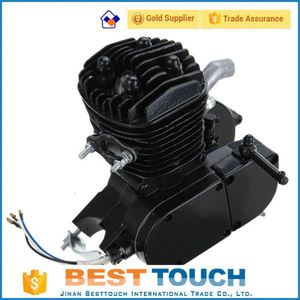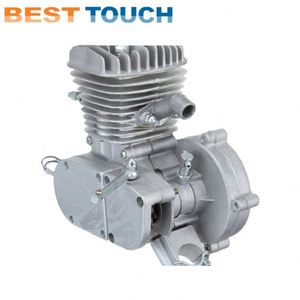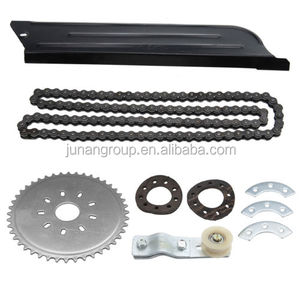(853 products available)










































































































































































































40 cc bicycle engines come in different types to suit various customer needs. Here are some common types:
2-Stroke Bicycle Engine
The 40 cc 2-stroke bicycle engine uses a simple design. It has two main parts: an intake and an exhaust port. During the first stroke, the piston moves down, and a fuel and air mixture enters from below. During the second stroke, the piston moves up, compressing the mixture in the cylinder before firing. These engines are popular because they are simple and light. They are also powerful and good for high-speed rides. However, they are not as efficient as the 4-stroke engines, and riders pollute the environment.
4-Stroke Bicycle Engine
The 40 cc 4-stroke bicycle engine has a more complex design than the 2-stroke engine. It has three main parts: intake and exhaust valves and a camshaft. The valves open and close at specific times, allowing the fuel and air mixture to enter and exhaust gases to exit. The engine goes through four strokes: intake, compression, power, and exhaust. As a result, these engines have more torque and are more efficient than the 2-stroke engines. They also produce fewer emissions and noise. However, they are heavier and more complex. Thus, some people use more effort to ride the bike.
2-Stroke Supercharged Engines
The 40 cc supercharged 2-stroke bicycle engine has a supercharger added to the basic engine design. The supercharger compresses more air into the cylinder, allowing more fuel to enter. As a result, these engines produce more power and are suitable for high-performance bicycles.
4-Stroke Dual Overhead Camshaft Engines
The 40 cc 4-stroke dual overhead camshaft bicycle engine has two camshafts located over the cylinder. Each camshaft operates a set of valves. The engine provides precise valve control, resulting in better performance and efficiency. As a result, these engines are ideal for racing or high-speed bicycles.
The specifications of the 40 cc bicycle engine vary from one manufacturer to another. However, the general specifications include:
Displacement
The engine has a displacement of 40cc, which is equivalent to 0.040 liters or 40 cubic centimeters. It is a small engine commonly used in applications such as chain saws, weed eaters, and other small power equipment.
Cylinder Arrangement
These engines have a vertical, in-line, or parallel cylinder arrangement. The cylinders are typically oriented vertically, allowing for efficient cooling and compact design.
Cooling System
The 40 cc bicycle engine is air-cooled. It relies on the flow of air around the engine to dissipate heat generated during combustion and engine operation.
Power Output
The engine generates about 1.5 to 2.0 horsepower (hp) or 1.1 to 1.5 kilowatts (kW) of power. This power output is suitable for applications requiring lightweight and portable power.
Torque
The torque specification for a 40cc engine is not standardized. The torque output can vary depending on the specific design and configuration of the engine. However, it is typically in the range of 2.0 to 4.0 lb-ft (pound-feet) or 2.7 to 5.4 N·m (newton-meters).
Fuel System
These engines have a carburetor fuel system. The carburetor mixes air and fuel in the appropriate ratio for combustion. It is important to ensure proper maintenance and tuning of the carburetor for optimal engine performance.
Ignition System
The 40 cc bicycle engine uses a CDI (Capacitor Discharge Ignition) system or magneto ignition system. The ignition system generates sparks at the spark plug to ignite the air-fuel mixture in the engine's combustion chamber.
Oil System
The 40 cc bicycle engine is a 2-stroke engine that requires a mixture of gasoline and 2-stroke engine oil. The oil is added to the fuel in the recommended ratio (usually 50:1 or 40:1) to ensure proper lubrication and engine protection.
Maintaining a 40 cc bicycle engine is important to ensure optimal performance, durability, and reliability. Here are some general maintenance tips:
Oil and Fuel
Use fresh, high-quality gasoline (regular unleaded) for fuel. Avoid using old fuel or fuel with additives not recommended for small engines. Use 2-stroke engine oil in the recommended ratio (usually 50:1 or 40:1) mixed with gasoline for proper lubrication.
Air Filter
Check and clean the air filter regularly to ensure proper airflow and prevent dirt and debris from entering the engine. Replace the air filter if worn out or damaged.
Spark Plug
Inspect the spark plug regularly for wear, carbon buildup, or damage. Clean or replace the spark plug as needed to ensure proper ignition and engine performance.
Fuel System
Inspect the fuel lines, fittings, and carburetor for leaks, wear, or damage. Clean and adjust the carburetor as per the engine's manual to ensure proper fuel-air mixture and engine performance.
Ignition System
Check the ignition system components, such as the spark plug, ignition coil, and CDI unit, for wear or damage. Replace or repair as needed to ensure proper engine ignition.
Engine Components
Inspect other engine components such as bolts, screws, and gaskets for wear, damage, or leaks. Tighten or replace as needed to maintain engine performance and reliability.
Cooling System
Clean the cooling fins and air passages around the engine to ensure proper air circulation and cooling. Check for any obstructions or debris that may affect engine cooling.
Throttle and Clutch
Check the throttle and clutch cables for wear, damage, or proper adjustment. Adjust or replace as needed to ensure optimal engine performance and response.
Regular Inspection
Perform regular inspections and maintenance as per the engine's manual. Follow the recommended maintenance schedule for oil changes, spark plug replacement, and other critical maintenance tasks.
Wholesalers need to consider several factors when sourcing for 40 cc bicycle engines to ensure they meet customers' needs and market demands. Here are some of them:
Capacity
Wholesalers should have a variety of 40 cc bicycle engines in different capacities to cater to customers with varying needs. They can find engines with a maximum output of 1.5 horsepower and 40 cc two-stroke or four-stroke engine variants.
Quality and Reliability
Quality and reliability are important considerations when purchasing 40 cc bicycle engines. Wholesalers should partner with reputable and reliable suppliers that can provide high-quality engines. They can read online reviews to get a glimpse of the engines' reliability and quality.
Ease of Maintenance
Another important consideration is the ease of maintenance of the 40 cc bicycle engine. Wholesalers should source for engines that are easy to maintain and with minimal requirements. Additionally, they should consider sourcing for engines with readily available replacement parts.
Weight and Size
Wholesalers should consider the size and weight of the 40 cc bicycle engine they want to purchase. Generally, larger and heavier engines tend to be more powerful but are also heavier and difficult to install. Smaller and lighter engines are easy to install and maintain but have reduced power output.
Cost
Last but not least, wholesalers should consider the cost of the 40 cc bicycle engines. It's advisable to have a budget and source for suppliers that offer engines within the set budget. Additionally, they should consider the tradeoff between quality and cost.
Some tools and materials needed to replace a 40 cc bike motor:
Once the tools have been collected, follow the steps below to replace the 40 CC bicycle engine:
Once the new engine has been installed, reconnect all the lines and electrical wires.
Q1: Are 40 cc bicycle engines good?
A1: Yes, the 40 cc bicycle engines are good. They offer a good balance of power and efficiency, making them suitable for various tasks, from commuting to more demanding uses. However, their suitability depends on the specific needs of the users.
Q2: How fast can a 40 cc bicycle engine go?
A2: Typically, a 40 cc bicycle engine can achieve speeds of 25 to 30 mph. However, several factors influence the speed, such as the bike's weight, the terrain, and the overall condition of the engine.
Q3: How do buyers maintain 40 cc bicycle engines?
A3: Regular maintenance is required to keep the 40 cc bicycle engines in good condition and to achieve optimal performance. Maintenance includes regular oil changes, cleaning the air filter, spark plug inspections, and regular general bike inspections.
Q4: Is a 40 cc engine good for a small pushbike?
A4: Yes, a 40 cc engine is good for a small push bike. It's powerful enough to give the pushbike a good boost without making it feel heavy or difficult to handle. This makes it ideal for small or lightweight pushbike owners, providing extra power for pedaling without compromising the bike's overall performance and agility.